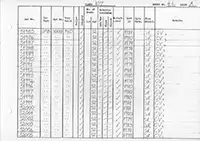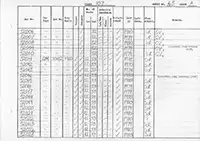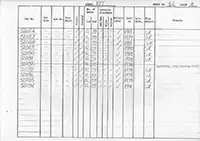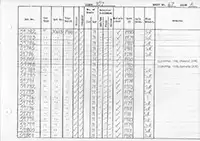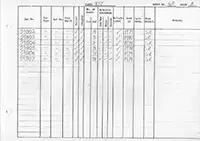Class 107 Derby 3-car DMUs
Description
The BUT equipment for the vehicles was ordered about November 1959.
The cars appeared very similar to the Class 108 'lightweights'. However, there were major differences. The 107s had more in common with the longer underframed 'heavyweights', having an overall width of 9' 3" and the same body profile, also being of all-steel construction and employing heavyweight bogies (DD10 for power cars and DT9 for trailers) identical to those on Classes 116, 117 and 118.
When viewed from the front, Class 107 driving cars most closely resemble the Derby Class 115 suburban stock with such features as roof mounted 4-character headcode boxes, cab front grab handles (2 vertical and 2 horizontal), and the later type of vacuum brake-pipe design hanging vertically from the buffer beam. This was introduced from 1959 on Derby built suburban stock and was quite different to the type used on Class 108 vehicles. The only external difference between the cab front of a 107 and a 115 was the buffer size, the smaller 18" diameter being fitted to 107s, as opposed to the very large 24" buffers of the 115.
The TS vehicles were virtually identical in outward appearance to the corresponding vehicles of Class 108, so much so that at the introduction of the TOPS numbering system the TS cars of both classes were allocated the same number, 161. This fact seems a little odd as the similarity was only skin deep, as bogies, construction material, seating capacity and of course weight were different.
However, the DMBS design was significantly different to that of Class 108 in that the brake compartment was re-designed with the two half-sized windows placed either side of the double opening loading doors as opposed to being immediately in front of the leading doors and there were no rear facing guards van windows either side of the corridor connection as on Class 108s.
Another feature of Class 107 power cars was the low slung engine position compared to 108 vehicles, also the engine coolant filler cap was mounted on the underframe of a Class 107 whereas this was only the case on 108s built from 1960, all earlier 108 power cars had bodyside mounted fillers.
While the 108s retained the low side windows of the original 'lightweights', the Class 107s windows were higher up.
Later on the AEC engines were replaced by Leyland ones, likely to be done when the vehicles were refurbished.
In the late '80s Scotrail abandoned first class accommodation for local services and the DMCs were reclassified as DMSs.
In 1986 a suspected transmission / axle defect saw the whole class withdrawn for several months until the bogies could be strengthened. Some were also fitted with Leyland 4041 engines, and this required shafts and mountings to be redesigned after one had an output shaft shear off in service and others bent.
Asbestos
The vehicles were built without blue asbestos. They were included in a vehicle log kept by the RTC at Derby dated circa 1984 which included the asbestos status for each vehicle, the pages of which are included below.
In the asbestos columns the / meant they were not built with blue asbestos, in the remarks column CV meant corridor van (a cage was fitted).
Summary
Description
Official
Numbering
Liveries
Operations
Refurbishment
Withdrawals
Non-Passenger Use
Images
Details about preserved Class 107s can be found here.



